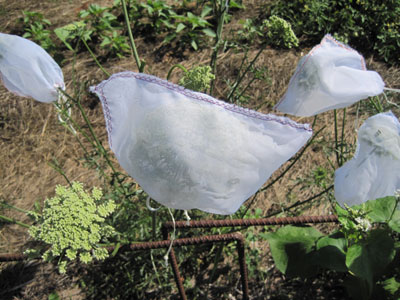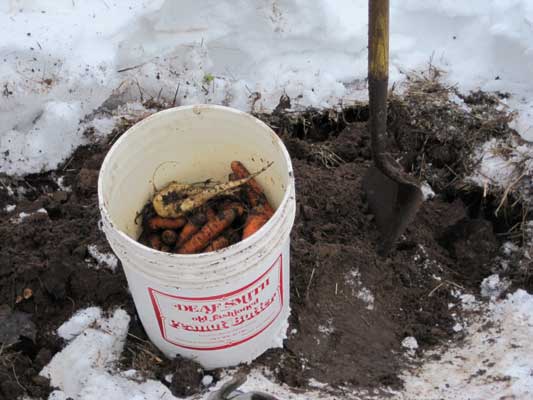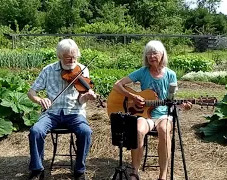July 17, 2019 -- Carrot Seed Adventures
Over the many years I’ve tried almost all the
open-pollinated carrots available and none have compared to Kinko 6" (a
chantenay type), which I started growing in 1980. It is sweet when
young, still very good flavor when old, good in storage, good
over-wintered, nicely shaped - a great all-round carrot. All this makes
it rather frustrating that it was dropped from the industry - the seed
is no longer available. For years I hadn’t noticed because I’ve grown my own seed
several times, keeping my own line alive and planting that. But my latest seed supply was running low so I started searching to
buy new seed. But there was none to be found.
So why not just grow my own again? In a way, carrot
seed is one of the easier seeds to grow. It's biennial so one has to
overwinter the roots, either inside storage or outside in the ground.
Both can work, depending on the weather. But there is one even bigger challenge
-- Queen Anne’s
Lace, which we have in abundance. QAL is the wild version of our garden
carrot. One can eat the roots but they tend to be thinner and longer,
rougher, harder to dig, white (which isn't a problem) and quite strong
flavored raw though they might be sweeter cooked. Our garden carrots have
been selected and bred over the years to be, generally, what we prefer.
The problem in growing seed is that the garden carrot will cross readily with QAL resulting in future roots that tend to
be strong toward the wild type.
When I grew my seed in the past I did my best to
mow, cut, pick, pluck the QAL flowers in our surrounding fields to avoid
crossing. This was no small endeavor, was fussy and time consuming,
futile in a way but I was moderately successful. I did my best and am OK with my crop of
not pure Kinko’s, with occasional white roots (which though rougher are
sweeter and more tender cooked than ‘regular’ carrots). But we have even
more QAL now and I didn't want to go through that again, nor do I want
even more wild genes in my tame seed.
The solution is to keep the pollinators from
visiting and carrying pollen from the wild flowers to the tame flowers
when they open. But, carrot flowers being as they are, do need to be
cross pollinated -- someone has to carry pollen from one flower to a
different plant's flower, easily handled by the pollinators, clumsily
handled by humans, at least this human. But I figured I could do that.
Normally I would choose my best roots in the fall, replant them in the
garden to grow the next year. But this time I didn't decide to do this
till I was digging the very last of the overwintered roots this spring,
and many of them had been a bit frozen on the tops and so, though good
for eating wouldn't grow a seed stalk. But I managed to get seven roots
to grow and flower and, like Queen Anne's lace, thankfully they do that
readily.
 Carrot/QAL
flowers are apparently well loved by a wide variety of and sizes of
pollinators. Keeping them off the flowers is no small task. I made 8"x8"
bags out of a light-weight fabric (maybe curtain sheers) found at the
thrift store. Originally I thought I'd just uncover them all, taking my
time, romantically and patiently hand cross pollinating the flowers with
a soft artist paint brush, then gently rebagging them. I didn't figure
it would be too hard to shoo off pollinators. Hah!! I had no idea there
were so many different insects of all sizes intent with firm purpose on
getting to those cute little carrot flowers. Many were waiting on the
bags, others zeroed in the moment that bag iwa untied, some manage to get
inside the bags. So in reality I quickly untied two or three bags at a
time, pulled the bags off, quickly ran the brush around back and forth,
flower to flower, around and back again, trying not to be too clumsy and
damage anything, quickly replace and tie them back on, all the while
shooing off all comers and reminding myself that a bit of crossing
isn't going to hurt, but hoping if the pollinators have just come from
another flower it is a nearby carrot not a distant QAL. I did go around inside the fence pulling off all
the QAL flowers I could find to aid this hope, but there are plenty more
outside the fence.
Carrot/QAL
flowers are apparently well loved by a wide variety of and sizes of
pollinators. Keeping them off the flowers is no small task. I made 8"x8"
bags out of a light-weight fabric (maybe curtain sheers) found at the
thrift store. Originally I thought I'd just uncover them all, taking my
time, romantically and patiently hand cross pollinating the flowers with
a soft artist paint brush, then gently rebagging them. I didn't figure
it would be too hard to shoo off pollinators. Hah!! I had no idea there
were so many different insects of all sizes intent with firm purpose on
getting to those cute little carrot flowers. Many were waiting on the
bags, others zeroed in the moment that bag iwa untied, some manage to get
inside the bags. So in reality I quickly untied two or three bags at a
time, pulled the bags off, quickly ran the brush around back and forth,
flower to flower, around and back again, trying not to be too clumsy and
damage anything, quickly replace and tie them back on, all the while
shooing off all comers and reminding myself that a bit of crossing
isn't going to hurt, but hoping if the pollinators have just come from
another flower it is a nearby carrot not a distant QAL. I did go around inside the fence pulling off all
the QAL flowers I could find to aid this hope, but there are plenty more
outside the fence.

To help keep track of what flowers I'm cross
pollinating I came up with the solution of sewing every two or three
bags with a different color thread and just unbagging each color at a
time. Almost all the bagged flowers are open now and I expect I'll be
doing this every morning for another two or three weeks, until they (hopefully) start
becoming seed heads. It is getting easier and rather fun in its own way.
Since I only have 7 plants this year I'll do it again next year with
more plants for greater genetic diversity in my seed. I'll know soon
enough if I've been a successful pollinator -- when the flowers do or
don't set seed . But I won't know until I plant the seed next year if
I managed to keep more QAL genes out of my home grown seed. Another
one of those little garden adventures I lay out for myself.
August 1 -- No new flowers so I'm done pollinating. One plant broke off
in the wind, another was too late so I ended up with only 8 flowers from 5
plants. Only 3 of those flowers pollinated (set seed). but I harvested my little
stash of valuable seed and look forward to seeing how they do next year.
But it was enough of a success that I decided to do it again, with more plants.
When I harvested carrots in the fall I chose 20 good roots to store in damp sand
in the root cellar, to be replanted in the spring. I also picked out another 20
and replanted those in the garden, one row along the north side of the plot, to
overwinter, well mulched.
2020 -- I planted my precious carrot seed along
with the older seed and it grew just fine, producing similar carrots. Success!
In early April I replanted the root cellar stored roots,
one row on the south side of the same plot that the overwintered roots were
planted, putting a stake by each plant to tie the seed stalks to. The
overwintered roots already had stakes; I just had to wait for them to grow.
Unfortunately, only two of them grew, one at each end, and one of those too late
to produce good seed heads. So I had one. The others? I'm not sure, either
frozen or eaten by voles.
Of the replanted roots only 3 grew, those in the middle
of the row. Sigh... But I carefully bagged what flowers I had when the were big
enough, and started the pollination routine. At some point I realized something
else was going on -- there were little worms in the seed heads, inside the bags,
and I learned about a fairly new comer in the local insect pest world - Purple
Carrot Seed Moth. Another sigh... In the end I harvest a small amount of good
seed from one nice seed head, a small amount from a small seed head, plus for a
test seed from an early flowering good but not-bagged seed head. I also decided
to go back to trialing available varieties.
2021 -- Planting last years saved seed was the
extent of my seed trails this year. The roots from the large seed head were
nice, similar to my regular crop sown at the same time. From the small seed head
only a few grew and they were OK, not as good as the large. The not-bagged seed
roots were, not surprising, definitely crossed with Queen Anne's Lace and though
edible, not worth it if one had regular carrots, which I did.
So is this the end of my carrot seed endeavor? Not likely. While I didn't select
and re-plant roots in the fall, I did, as I usually do, leave a plot of carrots,
heavily mulched, to dig in the winter and spring. If all goes well and there are
good roots in the spring I will leave a few rows to grow and set seed. But this
year I will bag the flower heads early, as soon as possible and hopefully before
the Purple Carrot Moth arrives. I'm also hoping someone else (of the insect or
bird variety) arrives when that moth shows up to do their own version of
harvesting.
 Carrots! - January 21, 2018
Carrots! - January 21, 2018
Above freezing, no wind, no precipitation -- a perfect day to
take care of some mid-winter outdoor chores. We were both in and out all day
enjoying just being outside. The carrots in the root cellar were almost out
so the timing was good to resupply. It's a bit messy but fun to be digging
in the dirt mid winter. Under the snow the mulch and down a few inches
was frozen, especially at the edge of the plot, but the carrots were fine -
fresh and crisp. The mulch and snow had done their job. There are more
carrots still in the ground to be dug in the spring. So I hope we have good
snow cover all winter this year. Meantime, we'll enjoy the "new crop"
freshly dug.
Copyright
© Susan Robishaw




 Carrot/QAL
flowers are apparently well loved by a wide variety of and sizes of
pollinators. Keeping them off the flowers is no small task. I made 8"x8"
bags out of a light-weight fabric (maybe curtain sheers) found at the
thrift store. Originally I thought I'd just uncover them all, taking my
time, romantically and patiently hand cross pollinating the flowers with
a soft artist paint brush, then gently rebagging them. I didn't figure
it would be too hard to shoo off pollinators. Hah!! I had no idea there
were so many different insects of all sizes intent with firm purpose on
getting to those cute little carrot flowers. Many were waiting on the
bags, others zeroed in the moment that bag iwa untied, some manage to get
inside the bags. So in reality I quickly untied two or three bags at a
time, pulled the bags off, quickly ran the brush around back and forth,
flower to flower, around and back again, trying not to be too clumsy and
damage anything, quickly replace and tie them back on, all the while
shooing off all comers and reminding myself that a bit of crossing
isn't going to hurt, but hoping if the pollinators have just come from
another flower it is a nearby carrot not a distant QAL. I did go around inside the fence pulling off all
the QAL flowers I could find to aid this hope, but there are plenty more
outside the fence.
Carrot/QAL
flowers are apparently well loved by a wide variety of and sizes of
pollinators. Keeping them off the flowers is no small task. I made 8"x8"
bags out of a light-weight fabric (maybe curtain sheers) found at the
thrift store. Originally I thought I'd just uncover them all, taking my
time, romantically and patiently hand cross pollinating the flowers with
a soft artist paint brush, then gently rebagging them. I didn't figure
it would be too hard to shoo off pollinators. Hah!! I had no idea there
were so many different insects of all sizes intent with firm purpose on
getting to those cute little carrot flowers. Many were waiting on the
bags, others zeroed in the moment that bag iwa untied, some manage to get
inside the bags. So in reality I quickly untied two or three bags at a
time, pulled the bags off, quickly ran the brush around back and forth,
flower to flower, around and back again, trying not to be too clumsy and
damage anything, quickly replace and tie them back on, all the while
shooing off all comers and reminding myself that a bit of crossing
isn't going to hurt, but hoping if the pollinators have just come from
another flower it is a nearby carrot not a distant QAL. I did go around inside the fence pulling off all
the QAL flowers I could find to aid this hope, but there are plenty more
outside the fence.

 Carrots! - January 21, 2018
Carrots! - January 21, 2018